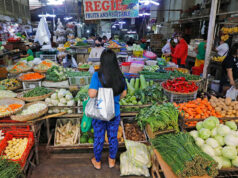Is this the bagoong of the mountains?
By Raymond A. Macapagal
IN MANY coastal communities of the Philippines, bagoong is an indispensable food item. This fermented mixture of salt and seafood (small fish or shrimp) keeps for months, assuring families of a tasty ulam (viand) during the lean fishing season when habagat winds, meaning the southwest monsoon, tear through the seas. Its intense saltiness helps it go a long way — one can eat a plateful of rice with just a spoonful of bagoong! Many weeks of fermentation unlock the umami-rich elements in the briny seafood that served as the flavor enhancer in soups and stir-fries long before the advent of monosodium glutamate powder or vetsin. Bagoong, however, is not unique to the Philippines. We share this fermented seafood culture with many of our neighbors like Thailand (where bagoong is called khapi), Cambodia (pra hok), Vietnam (mam ruoc), Malaysia (belachan), and Indonesia (terasi).
Human ecologist Kenneth Ruddle and cultural anthropologist Naomichi Ishige, in their 2010 article on the fermented fish products of Southeast Asia1, describe two types of bagoong: the shiokara type and the comminuted type. The first type, borrowing a traditional Japanese term, refers to highly salted whole fish like the padas of Pangasinan, which uses juvenile samaral (rabbitfish). The second type refers to the fine or ground-up paste like the ubiquitous bagoong alamang or guinamos, made from tiny shrimp and krill. Indeed, most people know bagoong to be made of seafood. But in the high mountains where fish or shrimp can hardly be found, do the people there also make some sort of bagoong?
The answer might be “no” if we restrict our definition of bagoong to seafood. In 1991, however, Perlito I. Ibarra and his colleagues at the University of the Philippines in Los Baños, successfully made bagoong, and its customary liquid by-product patis, from carabeef. If we expand the scope of raw ingredients to include other terrestrial animals then perhaps the pinayt of Batad may be considered a kind of bagoong.
All throughout the Cordillera mountain range, the indigenous peoples have developed various ways to preserve their meat. Because large animal slaughters only happen on rare occasions, the surplus meat from great feasts must be stored and preserved for the longest possible time. For example, the people of Sagada have the smoked pork jowl called etag. Bontoc has its sundried salt pork inasin. Kiangan has pinunnog, a smoked sausage. Most of these preserved meats are dry, and there is very little fermentation that happens. In Batad, a picturesque rice-terraced village in the province of Ifugao, there is the moist, fermented pinayt. It can best be described as a bagoong made of pork.
In the decade or so that I, a city-dwelling Tagalog, have been doing cultural work in the UNESCO World Heritage Cordillera landscape, I have mostly been used to eating their simple, almost primeval cuisine. There is inlagim, a smoky native chicken soup that derives its flavor from a fiery de-feathering process. But this rudimentary tinola (with no ginger, no chili leaves, no green papaya such as I am accustomed to) is served only on special days. Most of the time, we just eat legumes like balatong (mung beans) and kardis (pigeon peas) boiled with a little salt. I had thought there was nothing more to this ancient rice-centric montane food culture. That is, until one day when my neighbor Tito Juan brought out a thick bamboo tube hidden amongst his heirloom ceramic wine jars. As he carefully removed the banana leaf covering, an overwhelming putrid odor filled the air below his hut where we were drinking cuatro cantos, gin in a four-cornered bottle.
“Mun-akhub?” He asked if it smelled bad. My contorted face answered his question all too demonstratively. He sniffed again, and his contented countenance made me think that this was the odor he was looking for. “Pinayt hete,” he said while emptying the contents onto a basin then rinsing off the slippery liquid, and perhaps more than a few writhing maggots. As he cut the gray-brown meat into cubes, a bright red tocino-like interior was revealed. I picked up a piece to investigate. The meat was falling apart like an over-tenderized, aged, malodorous steak. As Tito Juan boiled the pork with balatong, a familiar scent wafted in the air. It was the smell of my local palengke fish section in San Juan City around noontime, when the market fishmongers open and clean their jars of raw fermented alamang.
Just like shiokara, pinayt is heavily salted chunks of pork that are placed in sealed bamboo containers and left to ferment for weeks. But it is not just any kind of pork. It has to come from naturally raised swine untainted by antibiotics and commercial feeds. Artificial ingredients tend to give the pork an unsavory flavor, or prevent the growth of the desired microbes. The people of Batad prefer their native p’ha-p’huy (pig) fed with giant taro corms and wild banana trunks. While the salting of the meat seems to be a straightforward process, the villagers believe that some people (like Tito Juan, and the noisy old bachelor Pawit) do it better than others. And that there is an art to it. Unlike the everyday bagoong, pinayt is a special dish, sometimes used as offerings in place of culled chickens in rituals. It is neither a side dish nor a condiment; it is given central importance as a viand in a meal. Its strong salty taste also assures that a lot of rice may be flavored with only a small amount of pinayt. Thus, pinayt can be shared with many people during community events and rituals.
As the mung beans cook, the pinayt in the kaldero (pot) all but disintegrates. We ladle a serving of the mushy soup onto our warm rice of the tinawon variety. Just as with the lowland shrimp paste, the raw putrefaction of pinayt mellows into a rich savoriness with some cooking. My palate recognizes that gamey, salty umami in the soup. I then realize that there, in a tiny mountain hamlet hundreds of kilometers away from the ocean, I might just have discovered the bagoong of the mountains.



